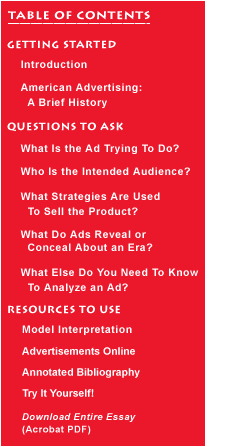talking history | syllabi | students | teachers | puzzle | about us

|
 |
|
In the first half of the twentieth century, most national advertising portrayed and promoted a world of mass produced, standardized products. Advertising and mass consumption would erase social differences. “We are making a homogeneous” people out of a nation of immigrants, proclaimed agency executive Albert Lasker in the 1920s. In more recent decades, however, marketing’s emphasis has been on segmentation—fitting a product and its marketing strategy to the interests and needs of a distinct subgroup. The historian Robert Wiebe has even suggested that the divisions—by economic, social, cultural and even psychological characteristics—now mark the United States as a “segmented society.”* Few advertisers try to sell the same thing to everybody today; too often that has meant selling to nobody. If segmentation is the norm in advertising, then it is crucial to ask for whom an advertisement or a campaign is intended. In the 1950s, the automobile industry was a stronghold of mass production and “follow the crowd” conformist marketing. The Doyle Dane Bernbach agency’s campaigns for the Volkswagen, introduced in 1959, broke out of the mold. Most frequently applauded for their visual and verbal wit and dramatic, uncluttered layout, the Volkswagen ads also stand as a triumph of segmentation marketing. To sell the VW in the late 1950s was a challenge. Volkswagen was a brand that Adolf Hitler had touted only two decades before as the German “people’s car.” It was small and spartan as American cars grew, sprouted tail fins and ornamentation, and added comfort features. Rather than reach for a broad market, the ads emphasized Volkswagen’s difference from the then-reigning “low-priced three” of Chevrolet, Ford, and Plymouth. Bold headlines proclaimed it ugly and small and boasted that its design had barely changed in years. The campaign depended on a devoted minority to make Volkswagen a marketing triumph. The Volkswagen buyer, in the eyes of marketers, shunned ostentation and took pride in practicality. One famous ad invited buyers to “Live Below Your Means,” presenting a car for people who could afford to spend more but chose restraint. Selected by Advertising Age magazine as the greatest advertising of the twentieth century, the Volkswagen campaign accelerated a trend toward segmentation marketing. It is worth noting that the advertising did not exist in a marketing vacuum. Sociologist Michael Schudson pointed out that Volkswagen registrations in the United States grew more rapidly the year before the campaign began than in its initial year.* To some extent, the vehicle, not its promotion, appealed to a certain class of auto shoppers. Nevertheless, advertising both aims at market segments and helps to shape those segments. A recent example of what can happen when a manufacturer attempts to redraw the boundaries of those communities can be seen in the anger of some Porsche owners at the sports car maker’s introduction of an SUV. In what must be one of the most vehement reactions, Mike Dini told the New York Times, “Every S.U.V. I’ve seen is driven by some soccer mom on her cellphone. I hate those people, and that Porsche would throw me into that category made me speechless. Just speechless.”*
|
|

|
|

